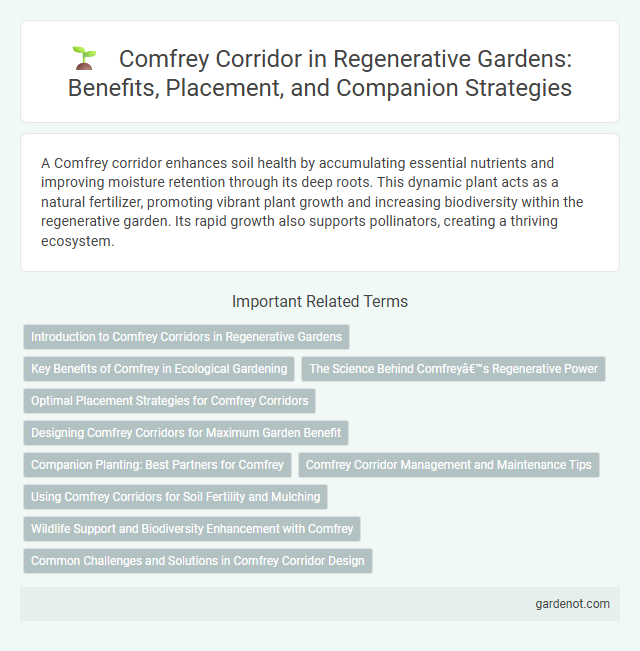A Comfrey corridor enhances soil health by accumulating essential nutrients and improving moisture retention through its deep roots. This dynamic plant acts as a natural fertilizer, promoting vibrant plant growth and increasing biodiversity within the regenerative garden. Its rapid growth also supports pollinators, creating a thriving ecosystem.
Introduction to Comfrey Corridors in Regenerative Gardens
Comfrey corridors are vital features in regenerative gardens, designed to maximize nutrient cycling and soil health through dense planting of comfrey plants. Known for deep roots that draw up nutrients from subsoil, comfrey enhances organic matter and supports beneficial insects. Integrating comfrey corridors improves garden resilience by providing mulch, forage, and natural pest deterrents.
Key Benefits of Comfrey in Ecological Gardening
Comfrey serves as a dynamic nutrient accumulator, drawing deep minerals and enriching soil fertility, which enhances plant growth and resilience. Its dense foliage provides effective ground cover, reducing weed competition and minimizing soil erosion in garden corridors. The plant's rapid biomass production supports sustainable mulch generation, feeding soil microbiomes and promoting a balanced regenerative ecosystem.
The Science Behind Comfrey’s Regenerative Power
Comfrey's deep taproot mines nutrients from subsoil layers, making essential minerals like potassium and calcium available to surrounding plants. Its high biomass production and rapid decomposition enrich soil organic matter, enhancing microbial activity and improving soil structure. Studies reveal comfrey's ability to bioaccumulate zinc and other trace elements, supporting overall ecosystem health in regenerative gardens.
Optimal Placement Strategies for Comfrey Corridors
Placing comfrey corridors near vegetable beds enhances nutrient cycling by facilitating deep nutrient mining and surface leaf mulch, enriching soil fertility naturally. Positioning these corridors along garden edges or pathways maximizes accessibility for harvesting comfrey leaves as mulch while minimizing crop shading. Strategic placement ensures efficient use of space, promoting biodiversity and supporting beneficial insect habitats within regenerative garden systems.
Designing Comfrey Corridors for Maximum Garden Benefit
Designing comfrey corridors involves strategically planting dense rows of comfrey to maximize soil enrichment and pest control. The deep roots of comfrey mine nutrients from subsoil layers, enhancing soil fertility, while its large leaves provide mulch that conserves moisture and suppresses weeds. Positioning comfrey corridors near vegetable beds facilitates nutrient sharing and creates beneficial habitats for pollinators essential to regenerative gardening systems.
Companion Planting: Best Partners for Comfrey
Comfrey thrives alongside fruit trees, tomatoes, and brassicas, enhancing nutrient cycling and improving soil health through its deep taproot that draws up minerals. Its dense foliage acts as a living mulch, suppressing weeds and retaining moisture, which benefits nearby companion plants by creating a favorable microenvironment. Integrating comfrey in a regenerative garden increases overall plant resilience and productivity by fostering symbiotic relationships and improving nutrient availability.
Comfrey Corridor Management and Maintenance Tips
Comfrey corridor management involves regular pruning to encourage vigorous growth and enhance nutrient accumulation, which supports soil fertility in regenerative gardens. Maintaining mulched beds around comfrey plants helps retain moisture and suppress weeds, reducing competition and promoting healthy root development. Periodic harvesting of comfrey leaves provides valuable mulch and compost material rich in potassium and nitrogen, essential for garden productivity and ecosystem balance.
Using Comfrey Corridors for Soil Fertility and Mulching
Comfrey corridors enhance soil fertility by accumulating deep-rooted nutrients and making them accessible to shallow-rooted plants, enriching the soil structure naturally. The large, nutrient-rich leaves of comfrey provide excellent mulch material that suppresses weeds, retains moisture, and boosts microbial activity when applied to garden beds. Utilizing comfrey corridors in regenerative gardens reduces reliance on synthetic fertilizers and promotes a sustainable nutrient cycling system.
Wildlife Support and Biodiversity Enhancement with Comfrey
Comfrey corridors provide essential habitat and food resources that boost local wildlife populations, attracting pollinators such as bees and butterflies while supporting beneficial insects like ladybugs. The deep roots of comfrey improve soil structure and nutrient cycling, fostering diverse plant communities and increasing overall garden biodiversity. Establishing comfrey corridors creates ecological connectivity, allowing species to thrive and enhancing ecosystem resilience in regenerative gardens.
Common Challenges and Solutions in Comfrey Corridor Design
Comfrey corridor design often faces challenges such as soil nutrient imbalances, invasive root spread, and water management complexities. Implementing deep mulch layers and strategic planting density effectively mitigates nutrient depletion and controls comfrey's aggressive rhizomes. Integrating swales or drip irrigation systems within the corridor enhances moisture retention, promoting robust plant growth and ecosystem resilience.
Comfrey corridor Infographic

 gardenot.com
gardenot.com